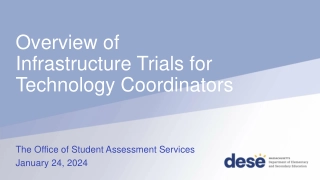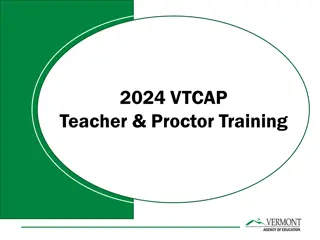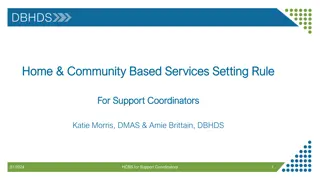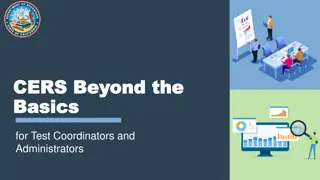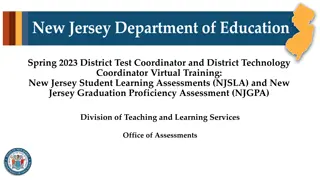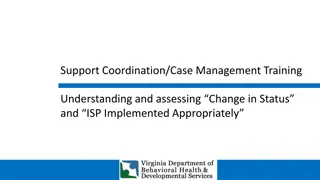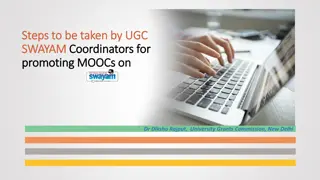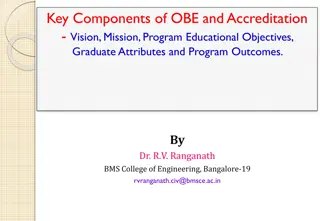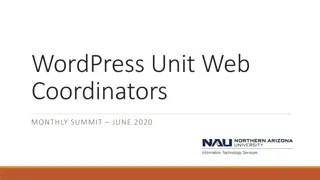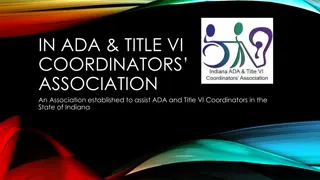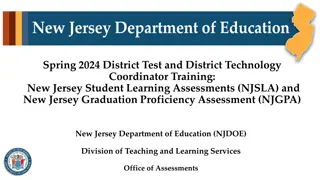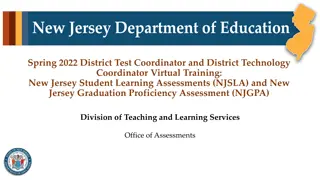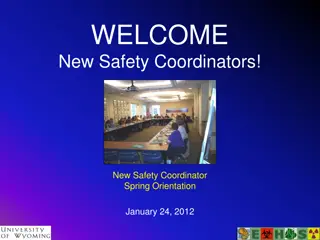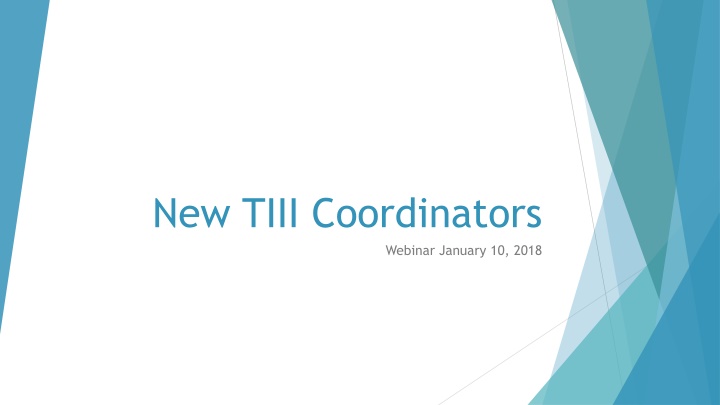
Insights into EL Program Demographics and Performance Metrics
Explore detailed information on English Learner (EL) program demographics, participation data, student progress metrics, and evaluation criteria. Gain valuable insights to optimize EL support strategies and enhance program effectiveness.
Download Presentation

Please find below an Image/Link to download the presentation.
The content on the website is provided AS IS for your information and personal use only. It may not be sold, licensed, or shared on other websites without obtaining consent from the author. If you encounter any issues during the download, it is possible that the publisher has removed the file from their server.
You are allowed to download the files provided on this website for personal or commercial use, subject to the condition that they are used lawfully. All files are the property of their respective owners.
The content on the website is provided AS IS for your information and personal use only. It may not be sold, licensed, or shared on other websites without obtaining consent from the author.
E N D
Presentation Transcript
New TIII Coordinators Webinar January 10, 2018
Plan Sections 1 EL demographics 2 Program goals and how they are measured 3 Identification of EL 4 EL program of service 5 Staffing and resources 6 Exiting EL 7 Equal access other programs 8 Parent/community involvement 9 Program evaluation and needs assessment
Section 1: Demographics Include as a chart or use the template Q 1-6 only asking for current would be important for you to look at monitored/former for other initiatives label them if you do ADI will have the growth you need for 16-17 all ELs, current, waived, ELSWD, monitored each year Demographics Yes/No; Signature Page Yes/No; statement of assurances Yes/No; EL Plan participation list; all 9 sections - must be there
Demongraphics cont. pg 2 2015/16 District Membership Grade White % Black % Hispanic % Asian % Indian/Alskn % Pacific Is. % Total K 1 2 3 4 5 6 7 8 9 21 21 21 28 18 27 20 25 17 20 29 31 39 317 30.4 28.8 30.9 35.9 22.2 32.1 29.0 29.1 27.0 24.1 33.0 38.7 26.2 29.6 0 1 1 0 0 1 2 2 0 0 0 0 2 9 0.0 1.3 1.4 0.0 0.0 1.2 2.9 2.3 0.0 0.0 0.0 0.0 1.3 0.8 48 50 44 47 62 54 46 55 42 62 56 48 105 719 70.0 68.5 64.7 60.3 76.5 64.3 66.7 64.0 66.7 77.1 63.6 60.0 70.5 67.1 0 0 0 1 0 1 0 2 1 0 0 1 1 7 0.0 0.0 0.0 1.3 0.0 1.2 0.0 2.3 1.6 0.0 0.0 1.3 0.7 0.6 0 1 2 1 1 1 1 2 2 1 2 0 2 0.0 1.3 2.9 1.3 1.2 1.2 1.4 2.3 3.2 1.2 2.3 0.0 1.3 1.5 0 0 0 1 0 0 0 0 1 0 1 0 0 3 0.0 0.0 0.0 1.3 0.0 0.0 0.0 0.0 1.6 0.0 1.1 0.0 0.0 0.3 69 73 68 78 81 84 69 86 63 83 88 80 149 1071 10 11 12 Totals Student count as of 10/1/2015 16
Student on waiver # of LEP Students on waiver 0 Building (as of 10-01-15) Grades Enrollment % of LEP Title IA SW Status Focus Gervais Elementary K-5 453 185 41% 0 SW Gervais Middle School 6-8 218 28 13% 0 SW Gervais High School 9-12 313 11 3.5% 0 SW Focus Douglas Avenue Alternative School 6-12 48 7 23% 0% District Total (data as of 10/1/12) K-12 1032 231 22% % of district students in program (1077 on 10/1/12) % of LEP students in program Special programs # of dist. students # of LEP students 0 0% 1.7% Talented and Gifted 18 22 15.1% 13.6% Special Education 146
Demongraphics cont pg 3 35% 50% AYP ALL AREAS 13/14 14/15 13/14 14/15 13/14 14/15 AMAO#1: Did students make adequate progress in language acquisition on the ELPA? 45.79% % 15.98% 42.67% AMAO #2: a & b Did students reach English language proficiency and exit the program. AMAO #3: Did ELL students meeting AYP in all categories? Not Met Not Met students in district % of students in district Monitoring year 1 86 8.5% Monitoring year 2 62 6% chart
Lets take a look see at the ADI AMAO data for growth Who will let me show their district data?
Section 2: Program Goals Please don t repeat this data in other sections Goals for program outcomes How effective is the program
Introduction Introduction: School District Information on Program Goals and Philosophy The DISTRICT is determined to provide the most appropriate educational approach for each student in any of our programs. Due to the ever increasing diverse languages in the District, DISTRICT has adopted an English Language Approach Model. Every building uses English Language Learner (ELL) Sheltered Instruction and every student receives English Language Development (ELD) class. In grades K-12 GSD provides all ELL students with teachers, administrators, and instructional assistants trained in the SIOP Model and English Language Development techniques. Gervais School District s Educational Approach Due to the diverse languages in the DISTRICT , Sheltered English with English Language Development (ELD) has been adopted as the most appropriate educational approach.
Program Goal Example The primary goal of the DISTRICT is to provide a program for ELL students that focuses on the acquisition of language that supports them as they are working to meet the ever-increasing rigor and demands of common core in academic content. The educational goals of DISTRICT S program of services for ELL students are: Equal access to comprehensible instruction in all academic areas; Meaningful participation in all District programs; Increased English proficiency; Increased depth of knowledge and increased academic language and vocabulary in common core/subject matter content.
Section 3: Identification Identification consistently across the state Language Use survey guidance/research/program guide (pgs 57-58) identification Look at numbered memorandum for ID phase in Stored in permanent file American Indian/Alaska Native identification process Monitoring Four years (exit year not counted, but need to monitor) First 2 years may be more intense Frequency must meet student need
Section 4: Program of Service Program models more details by EL groups ELSWD RAELs SIFE Provide by chart/school/program model No research here
Program Type Chart Example School Grade Level Program Type Frequency Elementary 1 K-5 Pull-Out :30 daily Elementary 2 K-5 Push-in :30 daily Middle School 6-8 Class PeriodPro :55 daily High School 9-12 Class Period :57 daily Private School --- --- --- Charter School --- --- --- RAEL Students K-12 Newcomer s Additional :30 daily SIFE Students K-12 Focused Afterschool Support Additional :30 2/wk ELSWD K-12 ---- ----
Section 5: Staffing and Resources Minimal changes Describe staffing qualifications, placement of EL students, strategies used in instruction For each of the EL program type you are providing Contingent plans for staffing changes
Section 6: Exiting ELs Exiting For all EL groups ODE will pilot local measures anyone interested? Email me. 17-18 last year to hold proficient student in program 18-19 proficient students must be exited if not done, ODE may automatically exit Promoting with evidence still an option (4 & 5 in domains) Monitoring 4 years now in full effect Frequency lack of success interventions waived student
Section 7: Equal Access for Other Programs Access to core all activities All people responsible Special Ed pre-IEP referral, EL staff included, best program, ensure language accessibility, TAG T-IA Grad plan for each EL group for 4 & 5 yr cohorts
Section 8 Parent & Community Involvement Communicating SB 1564 report Website and board With Parents Data analysis for making program evaluations (useful in section 9) TIII requirement Not just parent meetings, conferences, what are leadership roles? Input for program effectiveness, budget and narrative writing Input for writing this plan Part of all decision-making teams
Section 9 Program Evaluation Minor changes Former EL students out performing reg. students in reading and math All 4 years of monitoring Evaluation of EL parent participation in school (not just sign-in sheets) Needs assessment What needs to be improved (practices, communication, etc.) Compliance section timelines Concerns and how concerns are being addressed (if there are many, select one or two procedural/compliance ones
EL Plan Participants EL teachers EL program coordinators Building level administrators Content teachers District level administrators Special Education staff Fiscal staff Charter school staff TAG staff Instructional assistants Bilingual educators Title I-A staff Parents Community members Etc., as appropriate for your district
EL Plans are Due Feb 15, 2018 Due date to ODE February 15, 2018 ODE review time 45 calendar days from due date or receipt of plan, whichever is latest District notification of plan review Timeline for revisions 30 calendar days after receipt of ODE response
If Plans are NOT Approved Approved EL Plans are required for: State-weighted EL funding Title III allocations If the district s EL Plan is not approved prior to the 2018-19 Title III allocations being disseminated, the district s Title III sub-grant will be placed on a hold status in EGMS ODE SSF fiscal team will be notified that the district does not have an approved plan
Two Title III Fundable Conferences ODE/COSA EL Alliance Conference National Council of Title III Directors https://www.cosa.k12.or.us/even ts/2018ELA https://ncstiiid.org/national- meeting/ Conference Details Conference Details The agenda will include: Pre-conference Drs. Wayne Thomas and Virginia Collier, Dual Language Researchers, ELSWD morning session Jeff Zwiers afternoon session Office of English Language Acquisition (OELA) Leaders, General Conference Office of State Support (OSS ) Representative, Jeff Zwiers academic language A Parent Panel, Dr. Darryl Tukufu - keynote LEA and SEA break out sessions, Exhibitors Louise el Yaafouri - refugees
Contacts: Kim Miller Kim.a.miller@state.or.us 503-947-5712 Taffy Carlisle Taffy.carlisle@state.or.us 503-947-5688 Leslie Casebeer Leslie.casebeer@state.or.us 503-947-5648


